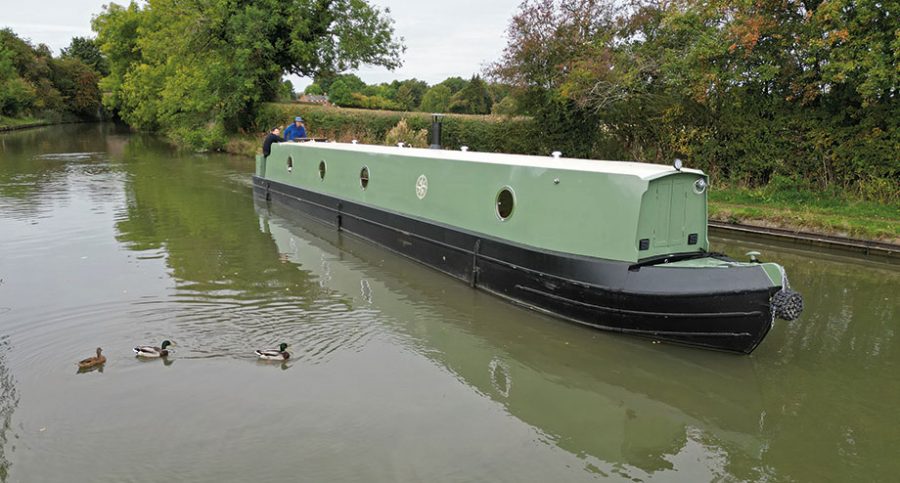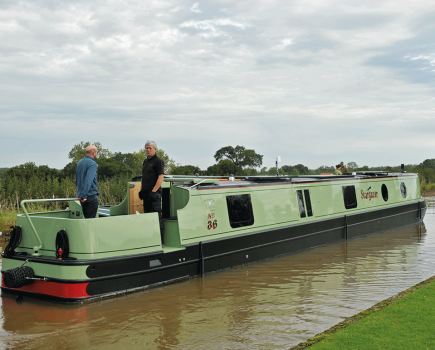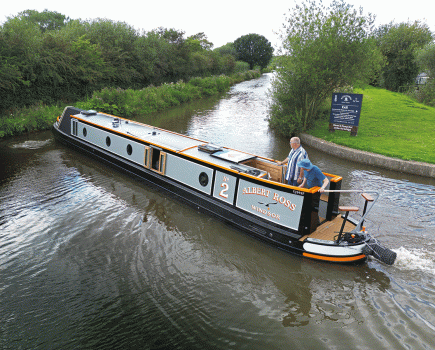No.7 demonstrates how purchasing from an experienced, but lesser-known, boat builder can deliver a quality boat at an attractive price.
In the current economic climate, we’re all asking ourselves what we can do to combat the rising cost of almost everything. If you’re in the market for a new boat, you’ll know that the prices of these have gone up too, thanks to big increases in the cost of things like steel and wood. And no-one can say when the situation will change, which means that if you put yourself on a two or three year waiting list for a boat, it’s impossible to know what the price will be by then.
One way to end the uncertainty is to buy a boat that’s already built. These are often called spec boats, because a builder produces them to a certain spec and then puts it up for sale, rather than building bespoke for a specific customer.
Another way of reducing the cost is to look at boats by lesser-known names because it’s certainly the case that you’ll pay a premium for a boat by the most respected builders. And that’s where this boat comes in. No.7 is, as the name suggests, the seventh boat built by Dan Cook – but it’s actually the first built specifically for sale. The previous ones he’s built for himself, lived in for a year and then moved onto the next. That means he’s got a lot of experience in both building boats and living on them, so has a good idea about what works and what doesn’t. He’s developed a layout which maximises space and uses good quality materials to produce a contemporary look and feel. And because he’s a one-man band, he can keep prices down too.
EXTERIOR
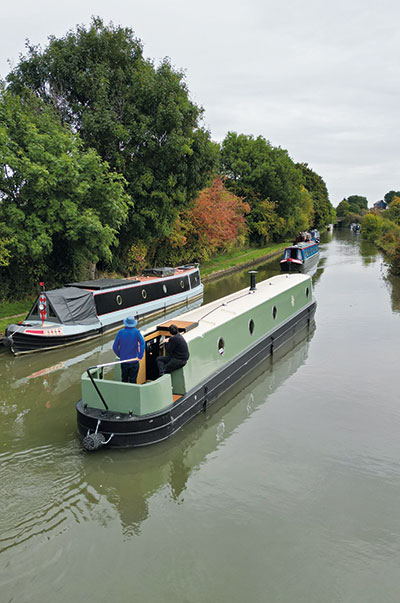 The key to the layout of this boat is very visible from the outside: it has an extended cabin at the bow rather than a well deck, meaning you get far more inside space than you’d expect from the 57ft length.
The key to the layout of this boat is very visible from the outside: it has an extended cabin at the bow rather than a well deck, meaning you get far more inside space than you’d expect from the 57ft length.
The shell is by S Jackson and Sons, who are not one of the big name builders, but they do have many years of experience producing boats. There are few fancy details – the handrails end in a simple curve rather than a scroll for example – but the basics are right: the sides look smooth and the corners are crisp. The bow is a rather nice shape too, and the extended cabin has been handled very well.
There’s a storage locker in the nose, with a stainless steel water tank underneath, which extends into the cabin. There’s a set of doors in the forward bulkhead. At the stern, there’s a solid metal dodger round the large cruiser deck rather than the more usual open framework, which gives a feeling of solidity and security. There are two lockers, one of which is the gas locker, while the other holds a spare bottle. The engine boards are made from checker plate, while the rest of the deck is covered in Eva Foam decking, a composite alternative to wood, which looks good and should need minimal maintenance.
The colour scheme uses a grey-green paint, which is very non-traditional, and the whole superstructure is the same colour, so there are no coachlines or contrasts. It means the boat has a very minimalist, contemporary look, but a future owner could easily add their own mark by having their chosen name sign-written to add some interest.
The roof is cream, which should help keep the boat cool in summer. Dan Cook paints his boats himself, using the top class facilities at Circus Field in Aylesbury. All the trim, such as the mushroom vents, are in chrome for the contemporary look and so cleaning is minimised.
The portholes are 18inch units by Caldwell’s, and are just single glazed on the basis that the glass area is small enough that double glazing would make very little difference. The portholes are also regularly spaced down the side of the boat, meaning it looks very uniform – and everything is in the right place.
LAYOUT AND FITOUT
This is a reverse layout boat, with the galley at the stern. This incorporates a breakfast bar, which opens onto a very generous saloon. A walk-through shower room comes next, with the cabin at the bow.
Dan Cook buys the shells through Lymm Marina, a company which specialises in sailaway boats. So it comes to him with the spray foam insulation done, and lined throughout. Lymm Marina also installs the engine and the first fix electrical. This means that someone like Dan who specialises in joinery doesn’t have to get involved in aspects he’s not so comfortable with.
The fitout uses oak faced ply below the gunwales and moisture resistant MDF panels above, routed to look like tongue and groove and painted white. The same material is used on the ceiling, helping to maximise the light. All the trim and the porthole liners are solid oak, while the floor is beautiful engineered oak. The mix of oak with painted cabin sides is very contemporary, and gives the boat a clean, bright feel.
Dan’s love of symmetry also informs his fitout technique. The portholes are all eight feet apart, and that just so happens to be the size the routed boards come in. That means there are no joins in odd places, and everything looks neat and tidy. It’s also a highly efficient way of working, with very little waste.
GALLEY
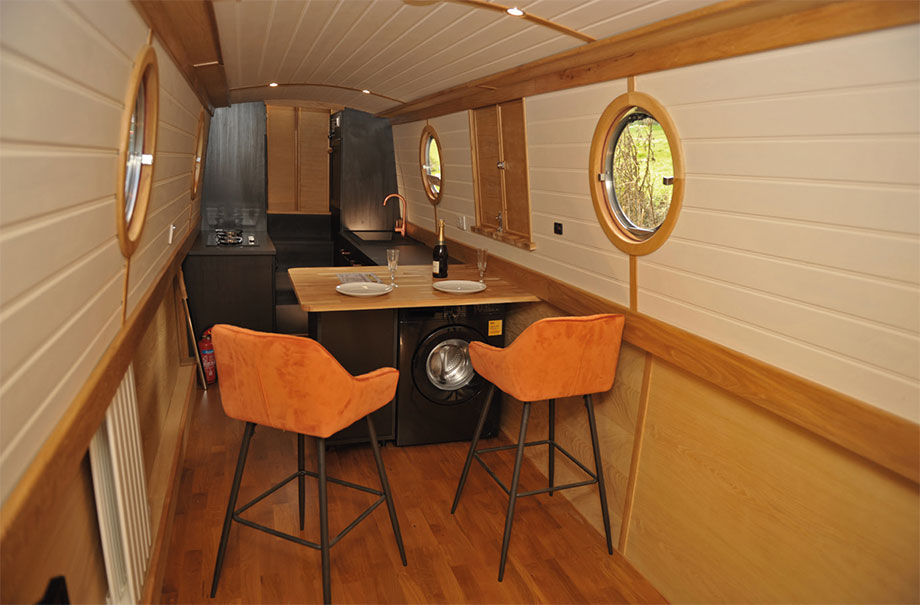 Three steps lead down from the stern deck into the galley. The treads of the top two steps lift, to provide storage for mooring pins and suchlike. On one side of the steps is the electrical cupboard, while opposite is another which offers full depth hanging space for coats. The central heating header tank is also in here, which means this cupboard has a source of warmth.
Three steps lead down from the stern deck into the galley. The treads of the top two steps lift, to provide storage for mooring pins and suchlike. On one side of the steps is the electrical cupboard, while opposite is another which offers full depth hanging space for coats. The central heating header tank is also in here, which means this cupboard has a source of warmth.
The galley itself is a dramatic black affair with modern copper handles, which makes for a stylish combination. The units come from IKEA, but have to be adapted to fit the shape of the boat. The worktops are laminate, while the inset sink is a composite. The tap and drain cover are copper to match. It’s an all-drawer galley, which Dan believes makes accessing everything much easier.
Equipment includes a Thetford three-burner hob and a Thetford oven. The black Smad fridge can run on 12 volts or 240 volts.
A breakfast bar made from solid oak woodblock extends from one of the runs of galley units. There are two comfortable bar stools, and there’s a washing machine hidden underneath in what would otherwise be a dead corner. There’s also a set of side doors, making this a very pleasant place to sit and eat, or just sit.
SALOON
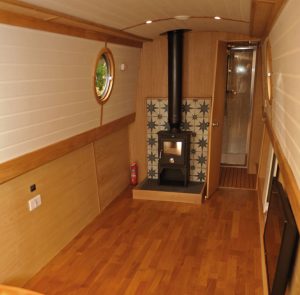 The saloon is very generously proportioned, at around 14ft in length. It’s left open for whoever buys it to install their choice or armchairs or sofa – and a sofabed would give the option of turning this into a guest room. There’s a 39inch flat screen tv under the gunwale, flanked by radiators equidistant each side.
The saloon is very generously proportioned, at around 14ft in length. It’s left open for whoever buys it to install their choice or armchairs or sofa – and a sofabed would give the option of turning this into a guest room. There’s a 39inch flat screen tv under the gunwale, flanked by radiators equidistant each side.
An attractive hearth with star design tiles holds a solid fuel stove by Reepham. It’s the latest hybrid design, meaning the body is stainless steel so heats up quicker, but the door is cast iron, so retains heat longer and looks more traditional. The flue is double insulated to comply with the latest guidelines, and there are air gaps behind the tiles to prevent heat transfer to the bulkhead.
SHOWER ROOM
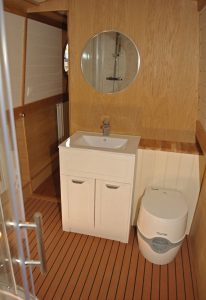 The first thing you notice in this room is the floor, because it’s made from the same self-adhesive foam decking material found on the stern deck. Not only is it moisture resistant and easy to keep clean, it’s also soft under foot. Dan has laid the floor in such a way as to make it easy to lift a section to gain access to the shower drain too.
The first thing you notice in this room is the floor, because it’s made from the same self-adhesive foam decking material found on the stern deck. Not only is it moisture resistant and easy to keep clean, it’s also soft under foot. Dan has laid the floor in such a way as to make it easy to lift a section to gain access to the shower drain too.
The shower cubicle is a generous 900mm quadrant, and is lined with laminate. The shower itself has a smart rain style head. In the interests of making everything accessible should something go wrong, all the workings of the shower can be accessed through the back of the wardrobe in the cabin.
On the opposite side of the room is the simplest form of Thetford cassette loo, a Porta Potti, and a storage unit with a countersunk basin.
CABIN
 The design of this boat, sacrificing a well deck in favour of more inside space, is immediately evident in the cabin. Because there are no front doors, the bed can take up the whole width of the boat – meaning a king size mattress fits easily. It also means that no-one has to climb over their companion to get in and out of bed.
The design of this boat, sacrificing a well deck in favour of more inside space, is immediately evident in the cabin. Because there are no front doors, the bed can take up the whole width of the boat – meaning a king size mattress fits easily. It also means that no-one has to climb over their companion to get in and out of bed.
Some of the space under the bed is taken up with the water tank, but lift the mattress and boards, and there’s a vast amount of storage space available. It would be easier to access if the boards lifted on gas struts, though. There’s a shelf at the head of the bed, and a set of small doors provides ventilation and an escape route. There’s a huge double wardrobe opposite the foot of the bed.
TECHNICAL
This boat is fairly straightforward technically. It’s powered by a Canaline 38hp engine, which is plenty powerful enough for a boat of this size. Canaline engines are used by many hire fleets, so should generally be reliable.
Electrical power comes from four 105Ah domestic batteries (and there’s one for the engine starter too), while a 240 volt supply comes via a Sterling 1600 watt inverter. All the sockets and switches on board are low profile and have stylish elongated switches. There are also plenty of 12 volt USB sockets, which are run direct from the 12 volt circuit, so they can be used without having the inverter turned on.
Central heating is from a Webasto diesel boiler. It’s the latest model, specially designed for boats, for greater reliability.
ON THE WATER
This is a boat which handles extremely well. It goes exactly where the tiller asks it to go, and we winded during our test with ease. It even goes backwards pretty well. For the helmsperson, the tiller is at a nice height, but as is often the case on cruiser sterns, the Morse control is quite low down; the whole design of a cruiser deck means there’s really nowhere higher for it to go. The instrument panel is just inside the rear doors, so it’s relatively easy to reach the switches or see the rev counter.
The engine isn’t the quietest, but it would be easy enough to put some soundproofing under the engine boards. There’s plenty of room on the stern deck for crew to keep the helmsperson company, and the gas lockers give them something to perch on, as well as being somewhere to put your mug of tea.
CONCLUSION
This boat has a lot to recommend it. The extended cabin means you’re maximising interior space; the shell is well built and handles very nicely; the layout inside is spacious and well thought out and the fitout is of a generally high standard.
Of course, these days price probably plays a bigger part in many people’s decisions than it used to. At the time of our test, the boat was for sale through Rugby Boat Sales (rugbyboats.co.uk)priced at a touch under £125,000. The cost of materials means that price is probably at least £20,000 higher than it would have been a year or two ago, so it’s fair to say that £125k is the new £100k. But you’d be hard pressed to find many brand new boats for this sort of money these days, meaning it’s excellent value.
And, importantly, this boat already exists, so it won’t be going up in price before you take delivery.
Dan Cook’s many years of boating experience really shows through. He knows what works and what doesn’t. So although he’s a boat builder who’s new to the market, and you probably won’t have heard of him before, we reckon he might just have a good future ahead of him.
THE BUILDER
 Dan Cook has been living and working on boats for around 12 years. He was first attracted to the waterways purely as a way of cheap living in London – although as this was more than a decade ago, the capital’s canals weren’t quite as crowded as they are now.
Dan Cook has been living and working on boats for around 12 years. He was first attracted to the waterways purely as a way of cheap living in London – although as this was more than a decade ago, the capital’s canals weren’t quite as crowded as they are now.
He quickly found that he could use his carpentry skills to do up boats, live on them for a while, then sell them to move on to the next project. He and a friend also became traders at the Mile End Floating Market in east London, having a boat selling hats – which, of course, was called the Chapeau Bateau.
It didn’t take long before Dan realised he could buy new shells to fit out, which in some ways is less work that refits. He worked on a layout that suited him and should therefore also suit other people, and a fitout style that should also appeal.
Currently, he also works for a friend installing kitchens – but would like to make boat fitting his full-time job. He has another shell on order which should be delivered to him early next year, and will take a few months to complete.

Length: 57ft
Beam: 6ft 10in
Shell: S Jackson and Sons
Style: Cruiser
Fit-out: Painted MDF, oak
Berths: 2 + space for sofabed
Engine: Canaline 38
Inverter: Sterling 1600
Galley units: Ikea – units from £150
Toilet: Thetford Porta Potti 565 – £115
Stove: Reepham Clean Burn 6.5kw – £375
Decking: Eva Foam – from £45/sheet
CONTACT: Dan Cook
TEL: 07904 898807
£124,950
 Words by Adam Porter / Pictures by Andy Annable
Words by Adam Porter / Pictures by Andy Annable
As featured in the December 2022 issue of Canal Boat. Available to buy here.

